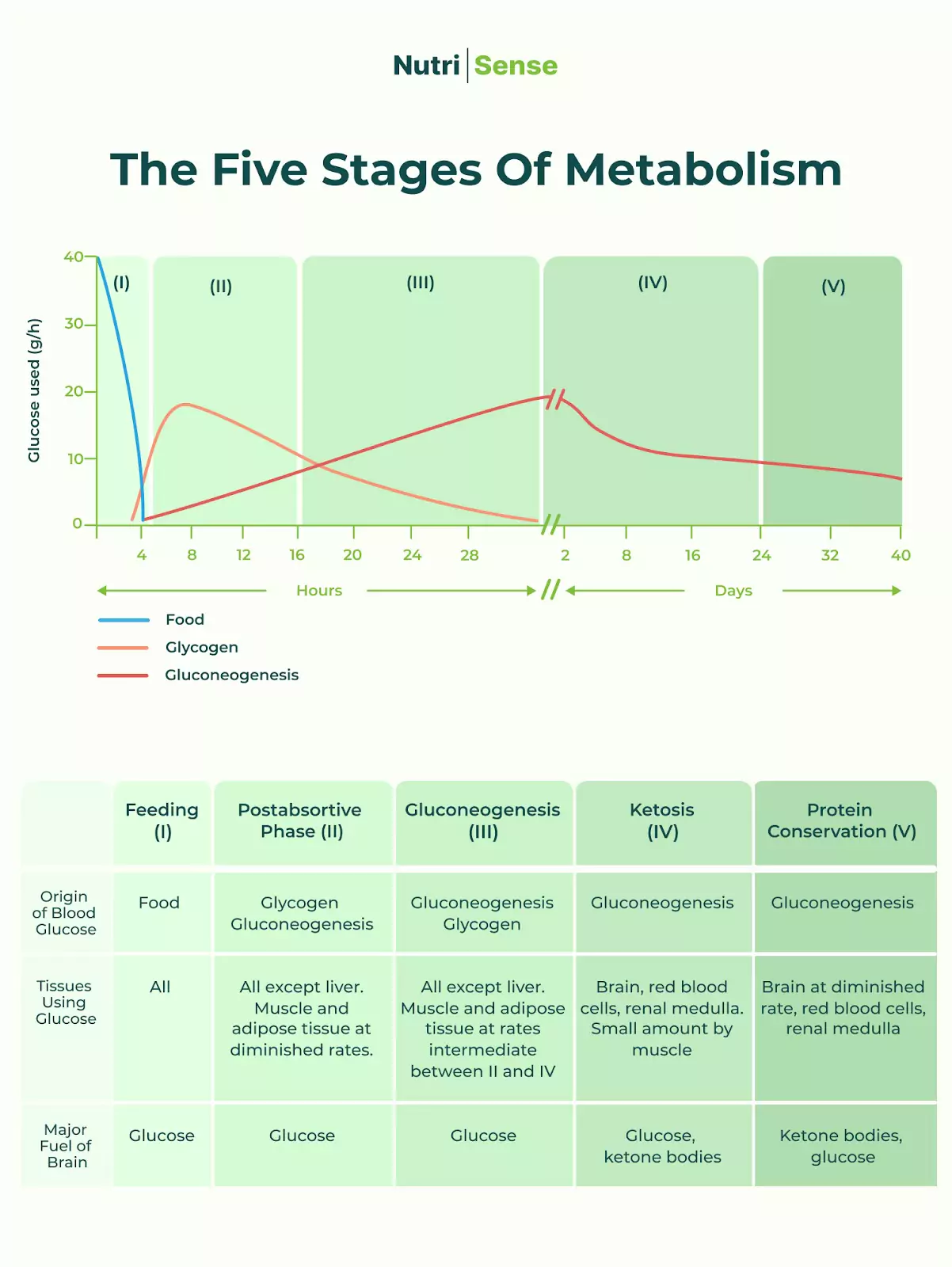How Many Meals Should You Eat in a Day?

Key Takeways
Have you ever wondered whether how often you eat has any impact on your health goals? While focusing on things like calorie intake, macronutrients, and healthy foods is essential, meal frequency is too—especially since it can impact everything from blood sugar levels to weight gain.
So, whether you’re working on metabolic health, weight loss, weight gain, or better sleep quality, it's a good idea to focus on the number of meals you eat during the day.
If you have diabetes, it's even more important to focus on how often you eat during the day. But there’s no one-size-fits-all when it comes to meal frequency, so it’s best to consult a nutrition expert (like a registered dietitian) before making any changes.
It's a good idea to know enough about the health benefits of eating a few big meals and many smaller meals throughout the day so you can pick what works best for your body. To learn more about the pros and cons of each eating pattern, read on!
The Impact of Many Smaller (Four to Six) Meals a Day

So, how does eating smaller meals more frequently impact your glucose levels, metabolic health, weight gain, activity level, and appetite? There are two sides of the coin here, as with all things related to health and wellness.
Advantages of Eating Four to Six Smaller Meals in a Day
Although there is limited evidence that four to six small meals a day favorably impact fat loss, there could be other advantages. Here are some people who might benefit from eating more frequently throughout the day:
- People with clinical hypoglycemia (when glucose drops below 70 mg/dL). Hypoglycemia is associated with shakiness, sweating, dizziness, nausea, and clammy skin.
- Those who have undergone weight loss surgery and may need to eat small meals.
- Those who have high activity levels or engage in exercise or other physical activity several times daily.
Disadvantages of Eating Four to Six Smaller Meals in a Day

Based on the points above, you’d think eating four to six meals a day was an easy choice for a healthy lifestyle. But since there’s no one-size-fits-all regarding the health benefits of different diet plans, there may also be disadvantages for some. Here are a few:
- Eating more frequently keeps the body in a fed state, which could mean higher glucose levels throughout the day. Research supports the idea that those who eat larger but fewer meals throughout the day have lower glucose levels than those who eat more frequently.
- Another significant drawback is that it may be challenging to tune into hunger or satiety signals because you’re never truly hungry but never truly full either! It can cause some confusion with appetite signals.
- A fascinating study conducted among healthy males may help explain this further. It found that a low-meal frequency diet increased satiety. It also reduced feelings of hunger compared with the group that ate more frequently.
- Recent research suggests that eating more than six meals daily versus three meals a day increases the risk for chronic disease, though, of course, correlation doesn't equal causation.
- Finally, eating small, more frequent meals has been touted to increase metabolic rate and fat burning, but the research does not back up this claim. While there is some increased thermoregulation when we eat from the digestion of our food, this does not seem to have a meaningful impact on metabolic rate.
- One study from 2010 found that subjects who increased their meal frequency but consumed the same amount of calories over eight weeks as the control group did not show improvements in fat loss or appetite over those who ate less frequently.
How Eating Like This Impacts Your Body’s Glucose Levels

Remember that hormones like insulin are stimulated to help process incoming food whenever you eat. When you eat larger meals or those high in refined carbohydrates and added sugars, they stimulate more significant amounts of insulin.
So, when you're grazing throughout the day, your body is always in a fed state. By allowing some time between meals, you're giving your body time to rest and allowing time for your glucose levels to come down.
New research from the Czech Republic shows that adults with type 2 diabetes who eat two large meals per day have better insulin sensitivity and increased weight loss than those who graze and eat more frequently, even when the total daily calories are the same.
For 12 weeks, participants ate six meals per day (breakfast, lunch, dinner, and three snacks). For the other 12 weeks, they ate only a large breakfast between 6 a.m. and 10 a.m. and a large lunch between 12 p.m. and 4 p.m.
Again, these findings suggest that it's not just meal frequency that matters; it's also a good idea to eat in alignment with your body’s circadian rhythm.
The Impact of Larger, Less Frequent Meals

Just like eating four to six smaller meals a day impacts everything from glucose levels to physical health, there are impacts of fewer, larger meals. From postprandial glucose levels to better circadian rhythms and lower stress levels, here’s what you should know about eating fewer, larger meals.
Advantages of Eating Fewer Large Meals in a Day
One study conducted in adults with type 2 diabetes found benefits from eating the largest meal earlier and a smaller meal for dinner. It led to reductions in postprandial glucose levels and lower average glucose levels throughout the day.
Overall, as research suggests, “a regular meal pattern including breakfast consumption, consuming a higher proportion of energy early in the day, reduced meal frequency (i.e., two to three meals a day), and regular fasting periods may provide physiological benefits such as reduced inflammation, improved circadian rhythmicity, increased autophagy and stress resistance, and modulation of the gut microbiota.”
Who Might Not Benefit From This Style of Eating?

Some groups of people might not benefit from eating less frequently. If any of this sounds familiar, you should consult your doctor before trying this eating pattern.
- It may not be an appropriate diet plan for those diagnosed with an eating disorder (including binge eating disorders).
- It can lead to overeating and excessive cravings, driving a negative emotional relationship with food.
- It may not be appropriate for those looking to lose or gain weight.
- It’s not the best eating pattern for anyone with clinical hypoglycemia or certain genetic conditions.
- It may not be suitable for those with thyroid conditions.
How Eating Like This Impacts Your Body’s Glucose Levels

One study conducted over two months among adults of ‘normal weight’ found that those who ate just one meal a day (eaten between 5 pm and 9 pm) exhibited higher morning fasting plasma glucose levels. They also had more significant, sustained glucose elevations and delayed insulin response in the oral glucose tolerance test (OGTT) than those who ate three meals a day. It’s important to take into consideration that the meal the subjects consumed was later in the evening when insulin sensitivity is diminished, so the timing of the meal and the composition could have had a role to play in the results!
Fasting levels of hormones like insulin, leptin, ghrelin, adiponectin, resistin, and brain-derived neurotrophic factor (BDNF) were not significantly affected by meal frequency.
One small scale study looked at the difference in glucose and insulin levels in subjects who consumed 6 versus 3 meals a day over 12 hours, and found that while insulin levels did not differ, the group that consumed more meals had elevated glucose levels throughout the day. Interestingly, the addition of protein attenuated the response to frequent meals.
Another study conducted among those with type 2 diabetes found that fasting until noon resulted in higher glucose levels after lunch and dinner.
Again, these findings suggest that both meal frequency and meal timing are important factors to consider.
Should You Consider Intermittent Fasting?

When talking about meal frequency, it makes sense to include a discussion about fasting. If you eat less frequently, you are technically doing some intermittent fasting already!
Intermittent fasting is somewhat new on the scene and in its infancy regarding available research. Most studies conducted are short-term, which is a drawback when considering the long-term ramifications of fasting.
Still, there are a few golden rules that the Nutrisense Nutrition Team believes benefit almost everyone. Here’s what they include:
- Aim for at least 14 hours of fasting every day.
- Consume most of your calories during daytime hours and limit food at least three hours before sleep.
- Try to minimize snacking or grazing between meals. Instead, focus on consuming enough at mealtime to feel satisfied for a while.
Apart from these tips, there are many other ways to explore different fasting styles. It’s a good idea to consult a registered dietitian to find the best practices for your body.
Advantages of Intermittent Fasting

Intermittent fasting can help with cellular autophagy (which is cellular waste clean up and sloughing off of old worn old cells). Though it’s hard to say for sure when autophagy occurs during a fast, studies have shown markers of autophagy after 24 hours of fasting.
Additionally, employing time-restricted eating and essentially eating most of your calories during daylight hours supports the body’s natural circadian rhythm. After seeing thousands of people's data, we've started to realize that when you eat is just as important as what you eat!
There’s also an interesting concept called Chrono nutrition, the intersection of circadian biology and nutrition. It turns out that all processes in your body function on a circadian rhythm, not just your sleep-wake cycle! Basically, ‘clocks’ in each of our organs dictate hormone secretion, insulin sensitivity, metabolic functions, nutrient absorption, appetite, glucose metabolism, body temperature, and much more. These processes work best when external cues (eating, sleeping, and exposure to light) align with these internal clocks.
So, to maintain optimal health, you should focus on aligning these external and internal cues so they can work harmoniously together.
One significant misalignment is late-night eating, especially with carbohydrates. So, it's common to see elevated glucose values overnight or a higher glucose response to a meal when you eat later in the day.
To back this up, one study conducted among men with prediabetes found benefits to time-restricted eating. Eating within a six-hour window and having dinner at 3 p.m. improved insulin sensitivity, blood pressure, oxidative stress, and appetite.
Another study suggests that eating within a time-restricted eating window (for example, between an 8 a.m. to 2 p.m. window) and aligned with the body’s circadian rhythm increases fat oxidation and reduces appetite in women.
Who Might Not Benefit From Intermittent Fasting?
As with all things, fasting may not be for everyone. If you fall into any of these groups, consider consulting a doctor or nutrition expert before you begin intermittent fasting:
- If you’re underweight (especially underweight women).
- If you’re pregnant or breastfeeding.
- If you’re on any medications that need to be taken with food.
- If you’re taking insulin (for both type 1 or type 2 diabetes)
- If you’ve been diagnosed with gastroesophageal reflux disease (GERD) or gout.
- If you’re under 18.
- If you have an uncontrolled thyroid condition.
How Eating Like This Impacts Your Body’s Glucose Levels

Preliminary research shows improvements in glucose and insulin levels during intermittent fasting. It could be beneficial for those with diabetes who may have hyperinsulinemia (high insulin levels) and insulin resistance in the muscles and the liver.
When in a fed state, your body uses the glucose from food for energy. When you’re past eight hours of fasting, your body regulates glucose using internal factors (versus external factors such as food). So it’s a complex interaction between hormones such as insulin and glucagon and other internal processes.
Glucagon is the hormone released when your glucose starts to get low. It stimulates:
1) The breakdown of your glycogen stores (stored glucose).
2) The creation of new glucose from noncarbohydrate sources (gluconeogenesis).
Usually, lower glucose levels, such as <70 or 80, trigger this. However, sometimes if you have a lot of glycogen stores (a lot of glucose in your liver and muscles), glucose could stay higher for a more extended period.
Also, remember that being under stress or having some form of insulin resistance may also stimulate gluconeogenesis. So, there are a few mechanisms at play here that are important to be mindful of.
Here is a great graph inspired by “The Complete Guide to Fasting” by Dr. Jason Fung that explains how glucose and fuel usage changes during fasting:

Find the right Nutrisense programto turn insight into progress.
Go Beyond Glucose Data with Nutrisense
Your glucose can significantly impact how your body feels and functions. That’s why stable levels are an important factor in supporting overall wellbeing. But viewing glucose isn't enough. Nutrisense, you’ll be able to learn how to use your body's data to make informed lifestyle choices that support healthy living.
One-to-one coaching
Sign up to access insurance-covered video calls to work with a glucose expert: a personal registered dietitian or certified nutritionist who will help tailor your lifestyle and diet to your goals.
Monitor and measure what matters
With the Nutrisense CGM Program, you can monitor your glucose with health tech like glucose biosensors and continuous glucose monitor (CGM)s, and analyze the trends over time with the Nutrisense App. This will help you make the most informed choices about the foods you consume and their impact on your health.
Find your best fit
Ready to take the first step? Start with our quiz to find the right Nutrisense program to help you take control.

Heather is a Registered and Licensed Dietitian Nutritionist (RDN, LDN), subject matter expert, and technical writer, with a master's degree in nutrition science from Bastyr University. She has a specialty in neuroendocrinology and has been working in the field of nutrition—including nutrition research, education, medical writing, and clinical integrative and functional nutrition—for over 15 years.




